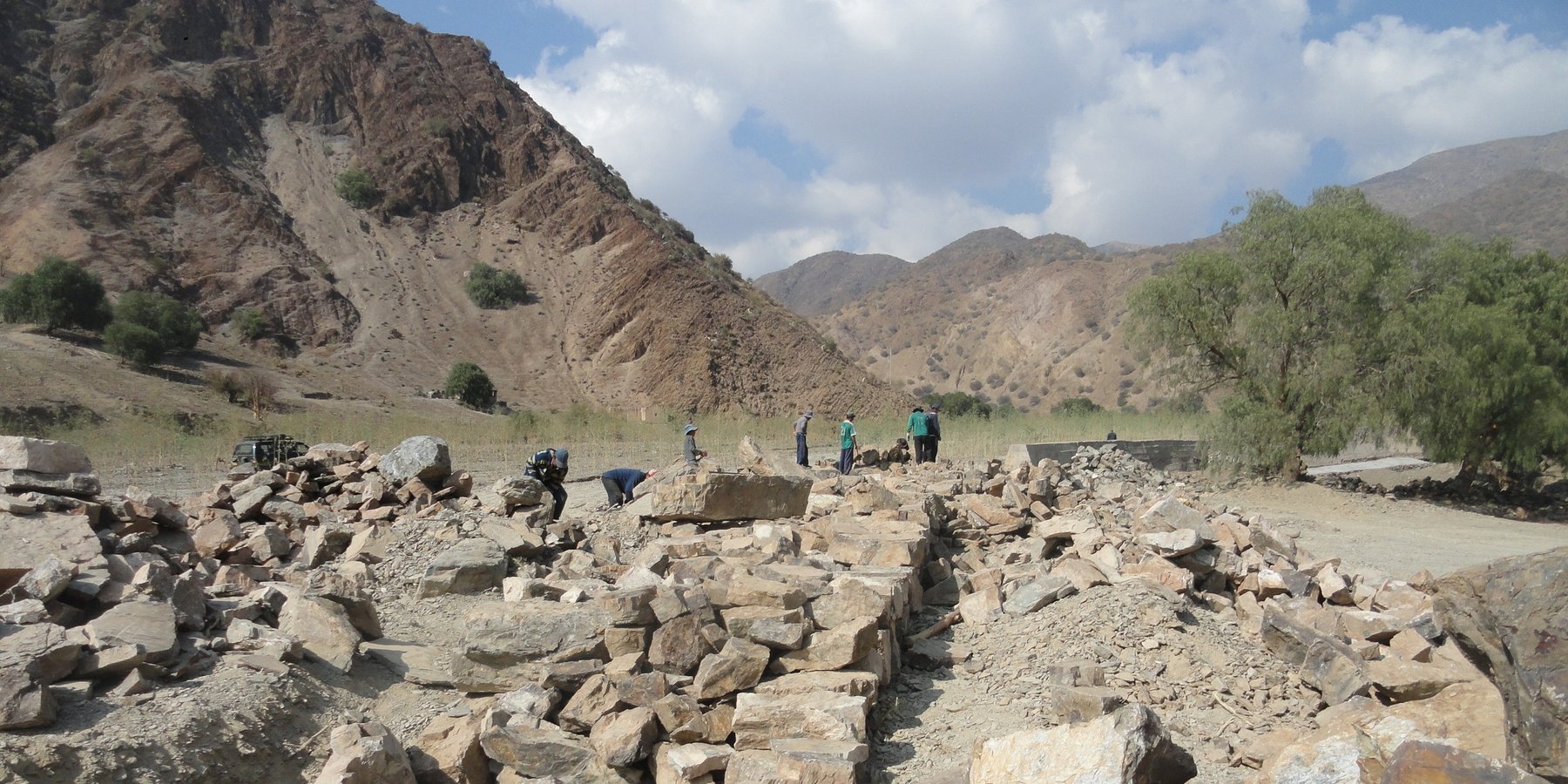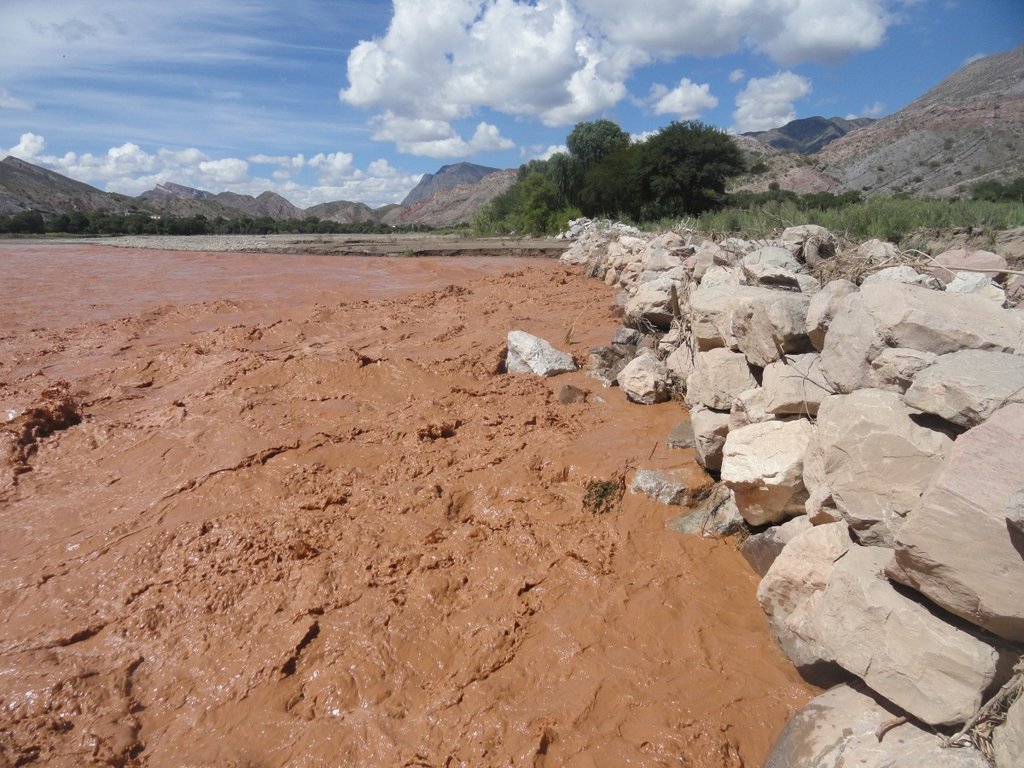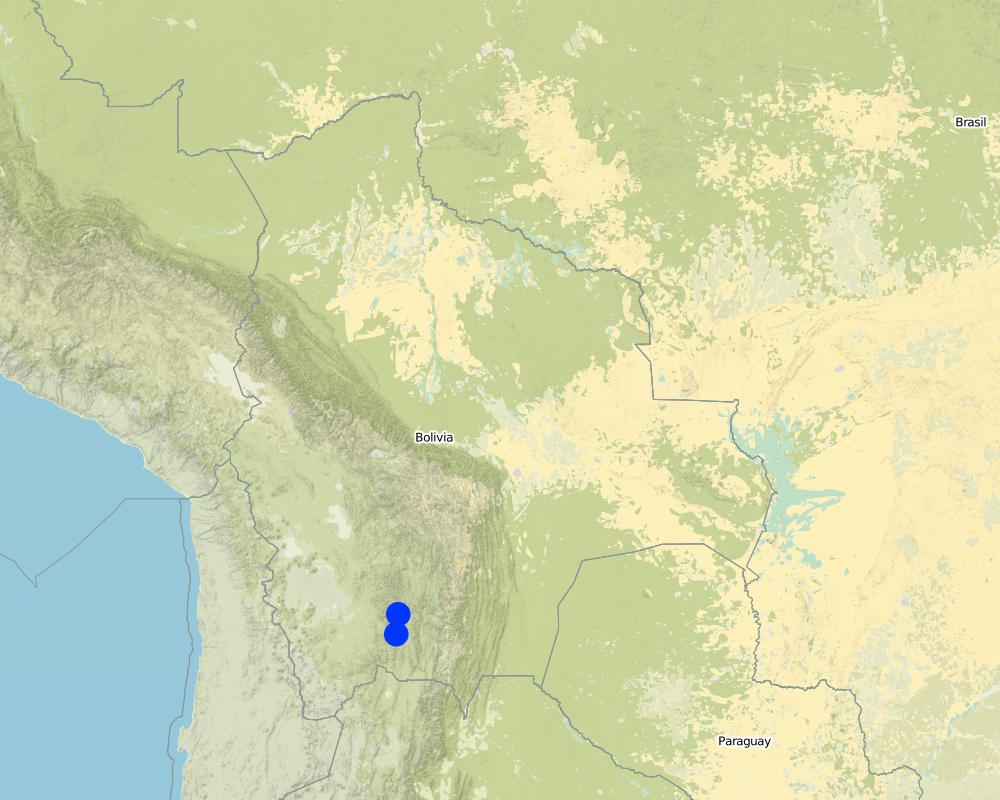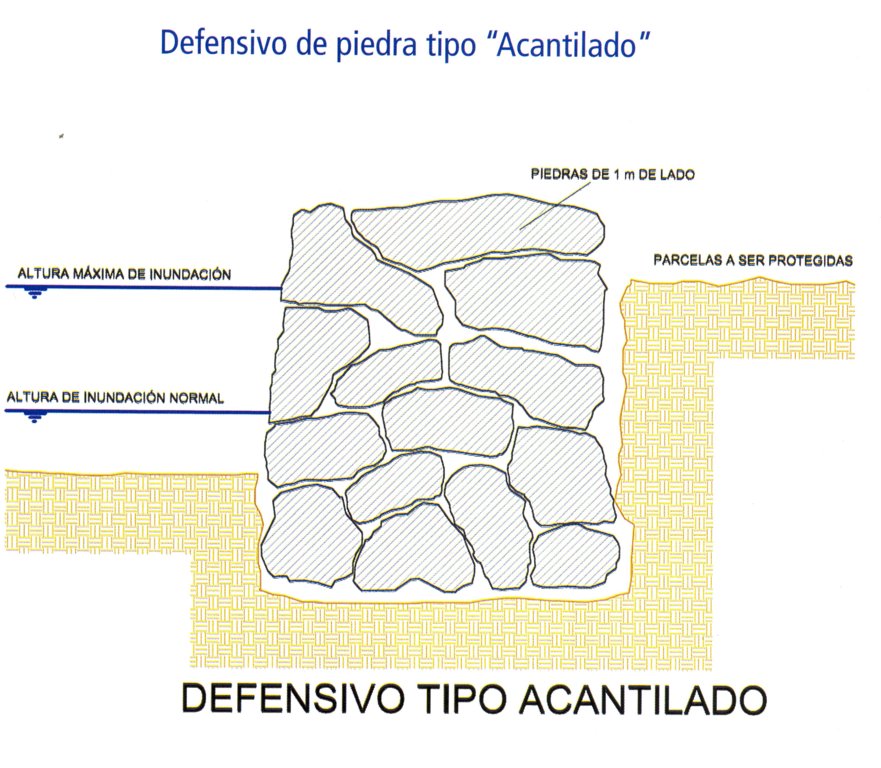Defensivo de piedra tipo "acantilado" [Bolivia, Plurinational State of]
- Creation:
- Update:
- Compiler: Marco Loma
- Editor: Consuelo Aranda
- Reviewers: Johanna Jacobi, Alexandra Gavilano
Enrocado
technologies_514 - Bolivia, Plurinational State of
View sections
Expand all Collapse all1. General information
1.2 Contact details of resource persons and institutions involved in the assessment and documentation of the Technology
Name of project which facilitated the documentation/ evaluation of the Technology (if relevant)
Book project: where people and their land are safer - A Compendium of Good Practices in Disaster Risk Reduction (DRR) (where people and their land are safer)Name of the institution(s) which facilitated the documentation/ evaluation of the Technology (if relevant)
HELVETAS (Swiss Intercooperation)1.3 Conditions regarding the use of data documented through WOCAT
When were the data compiled (in the field)?
05/03/2014
The compiler and key resource person(s) accept the conditions regarding the use of data documented through WOCAT:
Yes
1.4 Declaration on sustainability of the described Technology
Is the Technology described here problematic with regard to land degradation, so that it cannot be declared a sustainable land management technology?
No
Comments:
Es una tecnología rustica no complicada que sirve para proteger suelos cultivables
2. Description of the SLM Technology
2.1 Short description of the Technology
Definition of the Technology:
Defensivos flexibles y rústicos, se emplean para proteger terrenos de cultivo frente a amenazas de riadas y erosión lateral. esta conformada de rocas de gran diámetro con altura y espesor variable que puede ser complementada con plantación de árboles.
Su resistencia y flexibilidad permite que no se deforme fácilmente ante fuertes eventos de crecidas de agua.
2.2 Detailed description of the Technology
Description:
La tecnología puede, preferentemente, aplicarse en entornos naturales con amenazas de inundaciones dinámicas y en los margenes de ríos. Son defensivos flexibles y rústicos que se emplean para proteger terrenos de cultivos. esta conformado de rocas de altura y espesor variable, según requerimiento. Se aplican paralelos al cauce del río y al pie de terreno a protegerse. Entre los insumos a usar son: piedras de gran tamaño, retroexcavadora para movimientos de tierra para la nivelación y fundación, picos, palas, barrenas y palancas; volquetes para traslado de la piedra.
Vida útil de 10 años del defensivo, disminución de costos de rehabilitación, disminución de costos de afectación por inundaciones a viviendas y terrenos de cultivo. Su tecnología es apropiada y de bajo costo usando materiales locales y costos bajos de operación y mantenimiento.
2.3 Photos of the Technology
2.5 Country/ region/ locations where the Technology has been applied and which are covered by this assessment
Country:
Bolivia, Plurinational State of
Region/ State/ Province:
Provincia Sud Chichas;
Further specification of location:
Comunidades Colchas e Ichupampa.
Map
×2.6 Date of implementation
Indicate year of implementation:
2013
2.7 Introduction of the Technology
Specify how the Technology was introduced:
- as part of a traditional system (> 50 years)
Comments (type of project, etc.):
Se evaluó con las comunidades el mejor sistema que resistía las inundaciones en la zona y se eligió el acantilado como la mas duradera, por experiencias previas en otras zonas de la región.
3. Classification of the SLM Technology
3.1 Main purpose(s) of the Technology
- reduce, prevent, restore land degradation
- reduce risk of disasters
- adapt to climate change/ extremes and its impacts
3.2 Current land use type(s) where the Technology is applied

Cropland
- Annual cropping
- Tree and shrub cropping
Main crops (cash and food crops):
Papa, maiz, frutales como durazno
Comments:
Al reducir el riesgo frente inundaciones se protege la productión de hortalizas y productos frutales para la venta y el autoconsumo.
3.3 Further information about land use
Water supply for the land on which the Technology is applied:
- mixed rainfed-irrigated
Number of growing seasons per year:
- 1
Specify:
Son cultivos anuales como el maiz y la papa; asi como el durazno.
3.4 SLM group to which the Technology belongs
- surface water management (spring, river, lakes, sea)
- ecosystem-based disaster risk reduction
3.5 Spread of the Technology
Specify the spread of the Technology:
- applied at specific points/ concentrated on a small area
Comments:
La tecnología se aplica en lugares puntuales expuestos a inundacoines especialmente en zonas de meandros.
3.6 SLM measures comprising the Technology

structural measures
- S6: Walls, barriers, palisades, fences
Comments:
Los defensivos tipo acantilado son medidas estructurales para prevenir efectos de inundaciones en zonas de cultivo y en algunos casos en zonas de viviendas.
3.7 Main types of land degradation addressed by the Technology

soil erosion by water
- Wt: loss of topsoil/ surface erosion
- Wr: riverbank erosion
3.8 Prevention, reduction, or restoration of land degradation
Specify the goal of the Technology with regard to land degradation:
- prevent land degradation
4. Technical specifications, implementation activities, inputs, and costs
4.1 Technical drawing of the Technology
4.2 Technical specifications/ explanations of technical drawing
Para un defensivo de 100 m de longitud y 3 m de altura se utiliza:
Retroexcavadora 10 hrs.
Cargador frontal 50 hrs.
Volqueta de 12 m3 noventa viajes.
900 m3 de piedra.
80 jornales de mano de obra no calificada.
14 jornales de operador.
Forestación deseable con 67 plantines.
4.3 General information regarding the calculation of inputs and costs
Specify how costs and inputs were calculated:
- per Technology area
Indicate size and area unit:
10ha
If using a local area unit, indicate conversion factor to one hectare:
corresponde a un defensivo de 100 m de longitud y 3 m de altura
Specify currency used for cost calculations:
- US Dollars
Indicate average wage cost of hired labour per day:
20 USD/dia
4.4 Establishment activities
| Activity | Type of measure | Timing | |
|---|---|---|---|
| 1. | Visita al sitio | Other measures | antes de lluvias |
| 2. | Identificación y relevamiento de parcelas y datos de caudales, alturas de inundación | Structural | antes de lluvias |
| 3. | Dimensionamiento y cálculos estructurasles. | Structural | antes de lluvias |
| 4. | Replanteo y verificación del suelo | Structural | antes de lluvias |
| 5. | Organización social y provisión de herramientas | Other measures | antes de lluvias |
| 6. | Limpieza y desbroce | Structural | antes de lluvias |
| 7. | Excavacion de fundación | Structural | antes de lluvias |
| 8. | Traslado y acomodado de piedras | Structural | antes de lluvias |
| 9. | Forestación. | Vegetative | antes de lluvias |
4.5 Costs and inputs needed for establishment
| Specify input | Unit | Quantity | Costs per Unit | Total costs per input | % of costs borne by land users | |
|---|---|---|---|---|---|---|
| Labour | no calificada | dia | 80.0 | 12.0 | 960.0 | 100.0 |
| Labour | calificada | dia | 14.0 | 25.0 | 350.0 | |
| Equipment | retroexcavadora | hora | 60.0 | 30.0 | 1800.0 | |
| Equipment | volqueta | m3 | 1080.0 | 4.5 | 4860.0 | |
| Construction material | piedra | m3 | 900.0 | 3.0 | 2700.0 | 100.0 |
| Other | herramientas menores | global | 1.0 | 450.0 | 450.0 | |
| Other | plantines | unidad | 67.0 | 2.0 | 134.0 | |
| Total costs for establishment of the Technology | 11254.0 | |||||
If land user bore less than 100% of costs, indicate who covered the remaining costs:
El Proyecto reducción del riesgo de desastres financió la medida, la comunidad contribuyó con la mano de obra.
4.6 Maintenance/ recurrent activities
Comments:
no se require trabajos relevantes de mantenmiento
4.8 Most important factors affecting the costs
Describe the most determinate factors affecting the costs:
Distancia y acceso donde se encuentra el banco de materiales (principalmente las piedras / rocas) que condicionan el tiempo para el transporte
5. Natural and human environment
5.1 Climate
Annual rainfall
- < 250 mm
- 251-500 mm
- 501-750 mm
- 751-1,000 mm
- 1,001-1,500 mm
- 1,501-2,000 mm
- 2,001-3,000 mm
- 3,001-4,000 mm
- > 4,000 mm
Specify average annual rainfall (if known), in mm:
320.00
Specifications/ comments on rainfall:
Las lluvias mas intensas se producen entre los meses de diciembre - enero y febrero
Indicate the name of the reference meteorological station considered:
Vitichi y Tupiza
Agro-climatic zone
- sub-humid
El clima en la zona es sub-humeda con tenedencia a semi-arida.
5.2 Topography
Slopes on average:
- flat (0-2%)
- gentle (3-5%)
- moderate (6-10%)
- rolling (11-15%)
- hilly (16-30%)
- steep (31-60%)
- very steep (>60%)
Landforms:
- plateau/plains
- ridges
- mountain slopes
- hill slopes
- footslopes
- valley floors
Altitudinal zone:
- 0-100 m a.s.l.
- 101-500 m a.s.l.
- 501-1,000 m a.s.l.
- 1,001-1,500 m a.s.l.
- 1,501-2,000 m a.s.l.
- 2,001-2,500 m a.s.l.
- 2,501-3,000 m a.s.l.
- 3,001-4,000 m a.s.l.
- > 4,000 m a.s.l.
Indicate if the Technology is specifically applied in:
- not relevant
5.3 Soils
Soil depth on average:
- very shallow (0-20 cm)
- shallow (21-50 cm)
- moderately deep (51-80 cm)
- deep (81-120 cm)
- very deep (> 120 cm)
Soil texture (topsoil):
- medium (loamy, silty)
Soil texture (> 20 cm below surface):
- medium (loamy, silty)
Topsoil organic matter:
- low (<1%)
5.4 Water availability and quality
Ground water table:
5-50 m
Availability of surface water:
medium
Water quality (untreated):
for agricultural use only (irrigation)
Is water salinity a problem?
No
Is flooding of the area occurring?
Yes
5.5 Biodiversity
Species diversity:
- low
Habitat diversity:
- low
5.6 Characteristics of land users applying the Technology
Sedentary or nomadic:
- Sedentary
- Semi-nomadic
Market orientation of production system:
- mixed (subsistence/ commercial
Off-farm income:
- 10-50% of all income
Relative level of wealth:
- poor
Individuals or groups:
- groups/ community
Level of mechanization:
- animal traction
Gender:
- women
- men
Age of land users:
- middle-aged
Indicate other relevant characteristics of the land users:
Los usuarios son productores campesinos de la región.
5.7 Average area of land owned or leased by land users applying the Technology
- < 0.5 ha
- 0.5-1 ha
- 1-2 ha
- 2-5 ha
- 5-15 ha
- 15-50 ha
- 50-100 ha
- 100-500 ha
- 500-1,000 ha
- 1,000-10,000 ha
- > 10,000 ha
Is this considered small-, medium- or large-scale (referring to local context)?
- small-scale
Comments:
La totalidad del área pertenece a los usuarios campsinos
5.8 Land ownership, land use rights, and water use rights
Land ownership:
- individual, titled
Land use rights:
- individual
Water use rights:
- communal (organized)
5.9 Access to services and infrastructure
health:
- poor
- moderate
- good
education:
- poor
- moderate
- good
technical assistance:
- poor
- moderate
- good
employment (e.g. off-farm):
- poor
- moderate
- good
markets:
- poor
- moderate
- good
energy:
- poor
- moderate
- good
roads and transport:
- poor
- moderate
- good
drinking water and sanitation:
- poor
- moderate
- good
financial services:
- poor
- moderate
- good
6. Impacts and concluding statements
6.1 On-site impacts the Technology has shown
Socio-economic impacts
Production
crop production
Quantity before SLM:
Entre 40 y 60% de la producción perdida
Quantity after SLM:
Sin pérdida de la producción
Comments/ specify:
No se dispone del datos más exactos.
risk of production failure
Quantity before SLM:
Entre 40 y 60% de la producción perdida
Quantity after SLM:
Sin pérdida de la producción
Comments/ specify:
estimacion de perdida por los agricultores beneficiarios
Socio-cultural impacts
food security/ self-sufficiency
Comments/ specify:
reduccion de perdida de de la producción 40 a 60%, que es parcialmente para el autoconsumo
Ecological impacts
Climate and disaster risk reduction
flood impacts
Quantity before SLM:
2 veces al año
Quantity after SLM:
ninguna
Comments/ specify:
La zona protegida no ha sufrido inundaciones desde la implementacion en 2013
6.2 Off-site impacts the Technology has shown
Comments regarding impact assessment:
No se genera ningún impacto negativo, ya que el muro es de encauzamiento.
6.3 Exposure and sensitivity of the Technology to gradual climate change and climate-related extremes/ disasters (as perceived by land users)
Gradual climate change
Gradual climate change
| Season | Type of climatic change/ extreme | How does the Technology cope with it? | |
|---|---|---|---|
| seasonal temperature | summer | increase | well |
| seasonal rainfall | summer | increase | very well |
Climate-related extremes (disasters)
Hydrological disasters
| How does the Technology cope with it? | |
|---|---|
| general (river) flood | well |
| flash flood | very well |
Comments:
La tecnología es implementada en la zona. Considerando que con el cambio climático los eventos extremos aumentan en frecuencia y impacto causando precipitaciones fuertes y inundaciones, este tecnología se ha demostrado como medida apropriada.
6.4 Cost-benefit analysis
How do the benefits compare with the establishment costs (from land users’ perspective)?
Short-term returns:
positive
Long-term returns:
positive
How do the benefits compare with the maintenance/ recurrent costs (from land users' perspective)?
Short-term returns:
positive
Long-term returns:
positive
Comments:
Los beneficios con relación a los costos son positivos. La tecnología puede resistir inundaciones fuertes e inclusive resitir al arrastres de materiales y la erosión lateral.
6.5 Adoption of the Technology
- single cases/ experimental
If available, quantify (no. of households and/ or area covered):
10 a 20 familias
Of all those who have adopted the Technology, how many have did so spontaneously, i.e. without receiving any material incentives/ payments?
- 0-10%
Comments:
el acceso fisico y financiero para maquinaria externa necesaria (volqueta, retroexcavadora) limite fuertemente la replicación.
6.6 Adaptation
Has the Technology been modified recently to adapt to changing conditions?
No
6.7 Strengths/ advantages/ opportunities of the Technology
| Strengths/ advantages/ opportunities in the land user’s view |
|---|
| Es una tecnologia que puede durar en el tiempo y proteger parcelas. |
| Strengths/ advantages/ opportunities in the compiler’s or other key resource person’s view |
|---|
|
Los defensivos sirven para garantizar las inversiones de los usuarios - que es la produccion agricola- y su capital de base - que son los terrenos; ambos son protegidos por el defensivo. |
6.8 Weaknesses/ disadvantages/ risks of the Technology and ways of overcoming them
| Weaknesses/ disadvantages/ risks in the land user’s view | How can they be overcome? |
|---|---|
| Requiere de maquinaria para mover las piedras de gran diámetro y colocarlas unas encima de otras. | Negociar con el municipio para el apoyo con maquinaria. |
| Encontrar material cerca del lugar ya que de estar a distancias mayores los costos se incrementan. | Contar con recursos y hacer acuerdos previos con el municipio para contar con la maquinaria para facilitar el transporte. |
| Weaknesses/ disadvantages/ risks in the compiler’s or other key resource person’s view | How can they be overcome? |
|---|---|
| Contar con toda la información necesaria para el dimensionamiento detaillado del defensivo no siempre es posible | Tratar de buscar fuentes de informacion diversas incluyendo las communidades locales |
7. References and links
7.1 Methods/ sources of information
- field visits, field surveys
reunión con usuarios
- compilation from reports and other existing documentation
Dos reportes relativos a la tecnología utilizada y aplicada
7.2 References to available publications
Title, author, year, ISBN:
Tipologia de obras de infraestructura para aumentar la resiliencia en el sector agropecuario. Programa de Reducción del riesgo de desastres Eveline Studer y Marco Loma. 2014
Available from where? Costs?
Sin costo a través de la pagina web: www.rrd.com.bo.
7.3 Links to relevant information which is available online
Title/ description:
Tipologia de obras de infraestructura para aumentar la resiliencia en el sector agropecuario
URL:
http://www.rrd.com.bo/wp-content/uploads/2015/publi_fases/fase_03/14tipologiah1.pdf
Links and modules
Expand all Collapse allLinks
No links
Modules
No modules







